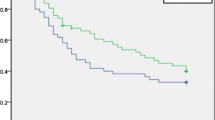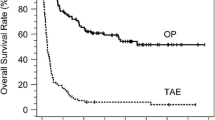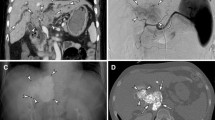Abstract
Purpose
To evaluate retrospectively whether technical factors of hepatic arterial embolization affect the prognosis of patients with hepatocellular carcinoma (HCC).
Materials and methods
Inclusion criteria of this study were the following: (1) patients received embolization as the initial treatment during 2003–2004, (2) Child A or B liver profile, (3) five or fewer HCCs with maximum diameter of 7 cm or smaller, and (4) no extrahepatic metastasis. Patient data were gathered from 43 centers. Prognostic factors were evaluated using univariate and multivariate analyses.
Results
Eight hundred fifteen patients were enrolled. The 1-, 3-, 5-, and 7-year overall survival rates were 92.0 % (95 % CI 90.1–93.9), 62.9 % (95 % CI 59.3–66.6), 39.0 % (95 % CI 35.1–43.0), and 26.7 % (95 % CI 22.6–30.8) in all patients. Univariate analysis showed a Child-Pugh class-A, alpha-fetoprotein level lower than 100 ng/ml, tumor size of 3 cm or smaller, tumor number of 3 or fewer, one-lobe tumor distribution, nodular tumor type, within the Milan criteria, stage I or II, no portal venous invasion, use of iodized oil, and selective embolization were significantly better prognostic factors. In the multivariate Cox model, the benefit to survival of selective embolization remained significant (hazard ratio 0.68; 95 % CI 0.48–0.97; p = 0.033).
Conclusion
Selective embolization contributes to survival in patients with HCCs.


Similar content being viewed by others
References
Llovet JM, Burroughs A, Bruix J. Hepatocellular carcinoma. Lancet. 2003;362:1907–17.
Cammà C, Schepis F, Orlando A, Albanese M, Shahied L, Trevisani F, et al. Transarterial chemoembolization for unresectable hepatocellular carcinoma: meta-analysis of randomized controlled trials. Radiology. 2002;224:47–54.
Llovet JM, Bruix J. Systematic review of randomized trials for unresectable hepatocellular carcinoma: chemoembolization improves survival. Hepatology. 2003;37:429–42.
Llovet JM, Real MI, Montaña X, Planas R, Coll S, Aponte J, et al. Arterial embolisation or chemoembolisation versus symptomatic treatment in patients with unresectable hepatocellular carcinoma: a randomized controlled trial. Lancet. 2002;359:1734–9.
Lo CM, Ngan H, Tso WK, Liu CL, Lam CM, Poon RT, et al. Randomized controlled trial of transarterial lipiodol chemoembolization for unresectable hepatocellular carcinoma. Hepatology. 2002;35:1164–71.
Ikeda K, Kumada H, Saitoh S, Arase Y, Chayama K. Effect of repeated transcatheter arterial embolization on the survival time in patients with hepatocellular carcinoma. An analysis by the Cox proportional hazard model. Cancer. 1991;68:2150–4.
Shim JH, Kim KM, Lee YJ, Ko GY, Yoon HK, Sung KB, et al. Complete necrosis after transarterial chemoembolization could predict prolonged survival in patients with recurrent intrahepatic hepatocellular carcinoma after curative resection. Ann Surg Oncol. 2010;17:869–77.
Chang JM, Tzeng WS, Pan HB, Yang CF, Lai KH. Transcatheter arterial embolization with or without cisplatin treatment of hepatocellular carcinoma. A randomized controlled study. Cancer. 1994;74:2449–53.
Kawai S, Okamura J, Ogawa M, Ohashi Y, Tani M, Inoue J, et al. Prospective and randomized clinical trial for the treatment of hepatocellular carcinoma: a comparison of lipiodol-transcatheter arterial embolization with and without adriamycin (first cooperative study). The Cooperative Study Group for Liver Cancer Treatment of Japan. Cancer Chemother Pharmacol. 1992;31:S1–6.
Malagari K, Pomoni M, Kelekis A, Pomoni A, Dourakis S, Spyridopoulos T, et al. Prospective randomized comparison of chemoembolization with doxorubicin-eluting beads and bland embolization with BeadBlock for hepatocellular carcinoma. Cardiovasc Interv Radiol. 2010;33:541–51.
Yodono H, Matsuo K, Shinohara A. A retrospective comparative study of epirubicin-lipiodol emulsion and cisplatin-lipiodol suspension for use with transcatheter arterial chemoembolization for treatment of hepatocellular carcinoma. Anticancer Drugs. 2011;22:277–82.
Nakao N, Uchida H, Kamino K, Nishimura Y, Ohishi H, Takayasu Y, et al. Determination of the optimum dose level of lipiodol in transcatheter arterial embolization of primary hepatocellular carcinoma based on retrospective multivariate analysis. Cardiovasc Interv Radiol. 1994;17:76–80.
Matsui O, Kadoya M, Yoshikawa J, Gabata T, Takashima T, Demachi H. Subsegmental transcatheter arterial embolization for small hepatocellular carcinomas: local therapeutic effect and 5-year survival rate. Cancer Chemother Pharmacol. 1994;33:S84–8.
Nishimine K, Uchida H, Matsuo N, Sakaguchi H, Hirohashi S, Nishimura Y, et al. Segmental transarterial chemoembolization with lipiodol mixed with anticancer drugs for nonresectable hepatocellular carcinoma: follow-up CT and therapeutic results. Cancer Chemother Pharmacol. 1994;33:S60–8.
Miyayama S, Matsui O, Yamashiro M, Ryu Y, Kaito K, Ozaki K, et al. Ultraselective transcatheter arterial chemoembolization with a 2-f tip microcatheter for small hepatocellular carcinomas: relationship between local tumor recurrence and visualization of the portal vein with iodized oil. J Vasc Interv Radiol. 2007;18:365–76.
Miyayama S, Mitsui T, Zen Y, Sudo Y, Yamashiro M, Okuda M, et al. Histopathological findings after ultraselective transcatheter arterial chemoembolization for hepatocellular carcinoma. Hepatol Res. 2009;39:374–81.
Takayasu K, Muramatsu Y, Maeda T, Iwata R, Furukawa H, Muramatsu Y, et al. Targeted transarterial oily chemoembolization for small foci of hepatocellular carcinoma using a unified helical CT and angiography system: analysis of factors affecting local recurrence and survival rates. AJR. 2001;176:681–8.
Ji SK, Cho YK, Ahn YS, Kim MY, Park YO, Kim JK, et al. Multivariate analysis of the predictors of survival for patients with hepatocellular carcinoma undergoing transarterial chemoembolization: focusing on superselective chemoembolization. Korean J Radiol. 2008;9:534–40.
Sacco R, Bertini M, Petruzzi P, Bertoni M, Bargellini I, Bresci G, et al. Clinical impact of selective transarterial chemoembolization on hepatocellular carcinoma: a cohort study. World J Gastroenterol. 2009;15:1843–8.
Takaki S, Sakaguchi H, Anai H, Tanaka T, Yamamoto K, Morimoto K, et al. Long-term outcome of transcatheter subsegmental and segmental arterial chemoembolization using lipiodol for hepatocellular carcinoma. Cardiovasc Interv Radiol. 2011 (Epub ahead of print).
Bruix J, Sherman M, Practice Guidelines Committee, American Association for the Study of Liver Diseases. Management of hepatocellular carcinoma. Hepatology. 2005;42:1208–36.
Minagawa M, Ikai I, Matsuyama Y, Yamaoka Y, Makuuchi M. Staging of hepatocellular carcinoma: assessment of the Japanese TNM and AJCC/UICC TNM systems in a cohort of 13,772 patients in Japan. Ann Surg. 2007;245:909–22.
Hatanaka Y, Yamashita Y, Takahashi M, Koga Y, Saito R, Nakashima K, et al. Unresectable hepatocellular carcinoma: analysis of prognostic factors in transcatheter management. Radiology. 1995;195:747–52.
Savastano S, Miotto D, Casarrubea G, Teso S, Chiesura-Corona M, Feltrin GP. Transcatheter arterial chemoembolization for hepatocellular carcinoma in patients with Child’s grade A or B cirrhosis: a multivariate analysis of prognostic factors. J Clin Gastroenterol. 1999;28:334–40.
Takayasu K, Arii S, Ikai I, Omata M, Okita K, Ichida T, Liver Cancer Study Group of Japan, et al. Prospective cohort study of transarterial chemoembolization for unresectable hepatocellular carcinoma in 8510 patients. Gastroenterology. 2006;131:461–9.
Lammer J, Malagari K, Vogl T, Pilleul F, Denys A, Watkinson A, PRECISION V Investigators, et al. Prospective randomized study of doxorubicin-eluting-bead embolization in the treatment of hepatocellular carcinoma: results of the PRECISION V study. Cardiovasc Interv Radiol. 2010;33:41–52.
Kumada T, Nakano S, Takeda I, Sugiyama K, Osada T, Kiriyama S, et al. Patterns of recurrence after initial treatment in patients with small hepatocellular carcinoma. Hepatology. 1997;25:87–92.
Acknowledgments
We thank the following institutions and doctors for supporting this study: (1) Okitama Public General Hospital, Department of Radiology, Hitoshi Ito, MD, (2) Toho University Omori Hospital, Department of Department of Gastroenterology and Hepatology, Manabu Watanabe, MD, (3) National Center for Global Health and Medicine, Department of Radiology, Kanehiro Hasuo, MD, (4) Tokai University, Department of Radiology, Takeshi Hashimoto, MD, (5) Yamanashi University, Department of Radiology, Hiroki Okada, MD, (6) Shinshu University, Department of Radiology, Kazuhiko Ueda, MD, (7) Kouseiren Takaoka Hospital, Department of Radiology, Koji Nobata, MD, (8) Ishikawa Prefectural Central Hospital, Department of Radiology, Takeshi Kobayashi, MD, (9) Hamamatsu University School of Medicine, Department of Radiology, Mika Kamiya, MD, (10) Nagoya City University, Department of Radiology, Masashi Shimohira, MD, (11) Aichi Medical University, Department of Radiology, Seiji Kamei, MD, (12) Shiga University of Medical Science, Department of Radiology, Norihisa Nitta, MD, (13) Kohka Public Hospital, Department of Radiology, Michio Yamasaki, MD, (14) Japanese Red Cross Kobe Hospital, Department of Radiology, Koji Sugimoto, MD, (15) Nishi-Kobe Medical Center, Department of Radiology, Yoichiro Kuwata, MD, (16) Wakayama Medical University, Department of Radiology, Nobuyuki Kawai, MD, (17) Hiroshima University, Department of Radiology, Hideaki Kakizawa, MD, (18) Chugoku Rosai Hospital, Department of Radiology, Akira Naito, MD, (19) Tottori University, Department of Radiology, Toshio Kamino, MD, (20) Shimane University, Department of Radiology, Msakatsu Tsurusaki, MD, (21) Oita University, Department of Radiology, Hiromu Mori, MD, (22) Kumamoto University, Department of Radiology, Osamu Ikeda, MD, (23) Kagoshima University, Department of Radiology, Yasutaka Baba, MD, (24) Kanazawa University, Department of Radiology, Tetsuya Minami, MD, (25) Hokkaido University, Department of Radiology, Daisuke Abo, MD, (26) Okayama University, Department of Radiology, Hideo Gobara, MD, (27) Osaka University, Department of Radiology, Keigo Osuga, MD, (28) National Cancer Center, Department of Radiology, Yoshito Takeuchi, (29) Teikyo University, Department of Radiology, Hiroshi Kotake, MD, (30) Japan Red Cross Kyoto Daiichi Hospital, Department of Radiology, Hiroyuki Morishita, MD, (31) Kochi Health Science Center, Department of Radiology, Yasuhiro Hata, MD, (32) Nanbu Medical Center, Department of Radiology, Fumikiyo Ganaha, MD, and (33) Keio University, Department of Diagnostic Radiology, Sachio Kuribayashi, MD.
Conflict of interest
The authors declare that they have no conflict of interest.
Author information
Authors and Affiliations
Corresponding author
Additional information
On behalf of the Clinical Research Group of the Japanese Society for Transcatheter Hepatic Arterial Embolization and Japanese Society of Interventional Radiology.
About this article
Cite this article
Yamakado, K., Miyayama, S., Hirota, S. et al. Hepatic arterial embolization for unresectable hepatocellular carcinomas: do technical factors affect prognosis?. Jpn J Radiol 30, 560–566 (2012). https://doi.org/10.1007/s11604-012-0088-1
Received:
Accepted:
Published:
Issue Date:
DOI: https://doi.org/10.1007/s11604-012-0088-1




